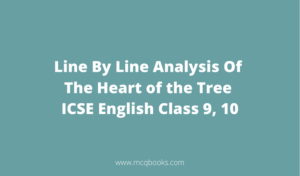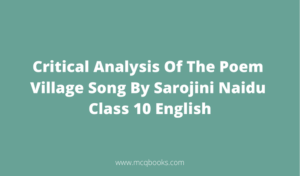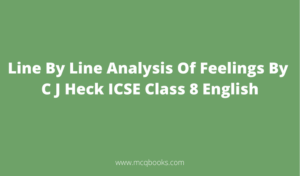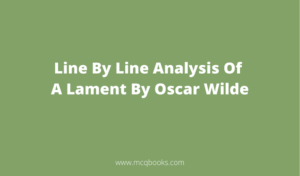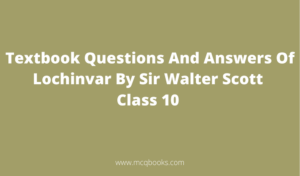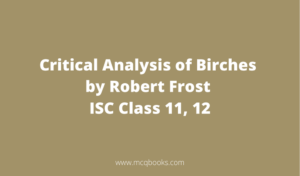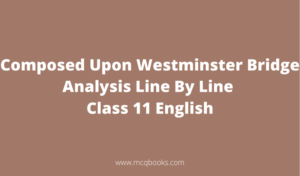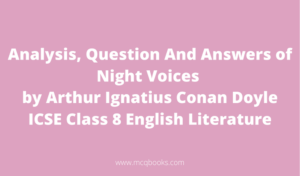An Angel in Disguise Extra Question And Answers ICSE Class 9, 10 English Literature
You are going to go through An Angel in Disguise Extra Question And Answers ICSE Class 9, 10 English Literature. Understanding a text meticulously in its entirety is very important for a learner for scoring better in the ICSE English exam. Experts made ample to ensure a thorough critical and line-by-line analysis. Let us find An Angel in Disguise Extra Question And Answers ICSE Class 9, 10 English Literature.
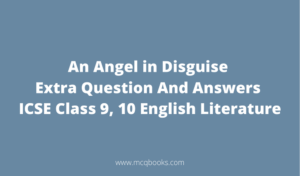
Extra Questions
1. Why did the people of the village hate the woman?
~ All the people in the village hated the woman because she was an alcoholic person. She used to beg to the other people for her living. The woman had been despised, scoffed at, and angrily denounced by nearly every man, woman, and child in the village. She died of an addiction to liquor, excessive drinking habits.
2. After her death, why did her neighbour’s attitude change?
The woman died leaving her three poor children. After her death, they were helpless and in poor condition. The neighbours also felt pity and their attitude changed for them as they had no food and clothes. They were alone, had no one to take care of them. Death touches the spring of the common humanity.
3. What was the matter of concern as the woman died?
The woman had three children, who were left helpless and poor after her death. The matter of concern for the villagers was that, who will be taking care of those poor ones. It would be cruel to leave them alone as they were young enough, they could do nothing for themselves, to live.
4. Describe the three children of the woman.
The woman had three poor children. The oldest one was named John. He was twelve years old. He had the capability to earn for his living. The second was Kate, she was a bright and clever one. The last one was Maggie, who was bedridden. She was the youngest and the helpless one. Falling from the window, she got injured in her spine and so she couldn’t leave her bed.
5. What happened to the children after her death?
Death of the woman left her three children poor and helpless. After the death of the drunken woman, the villagers decided to take each of the three children of the woman so that they can be raised properly. As they were young enough to do something for their survival.
6. Who took John? Who took Katy?
Farmer Jones said that he would take John, who was the oldest one among the three, and do well by him. Mrs. Ellis, who had been looking out for a bound girl, concluded that even though Katy was too young to be of much use, she would be adopting her.
7. What happened to Maggie?
Maggie was the youngest of all, who was nearly paralyzed. Falling from the window, she got injured in her spine and so she couldn’t leave her bed. Everyone in the village denied adopting her as she was considered to be the ‘burden’. One of the villagers suggested sending her to the poorhouse.
8. Why was Maggie considered to be a precious burden?
Mr. Joe Thompson felt like a burden to take the little girl home as he knew his wife won’t be ok with it. He even couldn’t leave her alone as he has got a soft heart, he couldn’t be so cruel to her. Besides Maggie was also precious for Joe’s family as she brought love in their family. She was like an angel to them, she changed their life and them too with her sweetness.
9. Why was Maggie bedridden? Which shelter was suggested for her?
Maggie the youngest child of the woman had fallen from a window and had injured her spine which made her bedridden.
Everyone in the village denied adopting her as she was considered to be the ‘burden’. One of the villagers suggested sending her to the poorhouse. They thought it would be the best place for her, they would take care of her properly.
10. Discuss how Maggie felt when she was left alone.
The youngest one Maggie was left alone due to her health. Falling from the window, she got injured in her spine and so she was bedridden and was of no use for anyone. The villagers left her alone in the old hut. She, catching her suspended breath cried to Joe to not to leave her alone. She felt helpless and was frightened, terror was reflected in her little face.
11. Discuss the line ‘It’s so cruel thing to leave her so’.
Joe Thompson said this as he was having pity on her. He was sympathetic to see that the villagers took the other two children and as Maggie was not stable physically, no one was interested to take her. They were ready to leave her alone, with a decision to send her to the poorhouse.
12. What assurance did Joe Thompson give to Maggie?
When Maggie pitifully begged Thompson not to leave her alone, he assured her that she won’t be left alone. When everyone was ready to leave her alone, he wrapped her in his arm, he lifted her gently and took her with him towards his home.
13. Character sketch of Joe Thompson.
Mr Thompson was a kindhearted man, who took the poor, helpless girl to his home when everyone was ready to leave her alone. He is presented as a strong man but has a soft heart. His discussion brings a twist, a change. He had no children and so he loved that poor girl, like his own daughter. He was ready to face his wife’s harsh reaction.
14. How did Mrs Thompson react when she saw Maggie?
Mrs. Thompson is presented as an ill-tempered woman. When she saw her husband bringing the poor girl in their home, she got mad at him. She showed anger and astonishment to Mr. Thompson. She asked him the reason behind bringing her home. She also asked him to leave her to the poorhouse as soon as possible.
15. What reason did Joe give to his wife for bringing the child home?
Joe old his wife how the other villagers were ready to leave this poor girl alone but he couldn’t act so cruel. He had brought Maggie home because she could not walk to the poorhouse. He assured her that he would leave her there the next day speaking to the guardians of the poor house.
16. Discuss the miserable condition of the woman and her children.
The woman was a poor person, though not necessarily a beggar or a charity case because she was an alcoholic person. She used to beg to other people for her living. She had three children’s, who were young enough to work for their food or survival. Their condition was pathetic. She died due to addiction to liquor, leaving her children alone and helpless.
17. Why did he plead to keep Maggie for a day?
Mr. Joe said, his wife that he had just brought Maggie for a single night, he promised to send her to the poor house the very next day. He also said to her, how she was left alone. All the villagers hurried up after the funeral, they left her alone in the old hut, in the hot sun.
18. What did Joe see from the window?
While returning to home, Joe saw a light shining from the window. He considered it to be a good sign. He saw Maggie lying a little raised on the bed and his wife was sitting having her back to the window. They were having conversations without hatred, negativity. He was happy to see that they were developing a bond.
19. What did Joe experience from Maggie’s facial expression?
Joe got positive vibes from the facial expression of the little one. He was relieved and happy to see the positivity, his wife’s hatred was decreasing. He saw the small sweet face filled with childishness. He had pity and love for the little one.
20. What did Maggie tell Joe?
When asked, Maggie said Joe how she used to fall sick very often, the doctor used to come but always late. She said she had a pain when he had lifted her but now she is comfortable. She is having no pain now, she got adjusted in the soft bed.
21. Why did Joe did not see the Guardians of the poor on that day?
Joe did not see the Guardians for Maggie on that day nor on the day following. In fact, he never saw them at all on Maggie’s account because Mrs Thompson had changed, she started loving Maggie. Later they decided to adopt her as their own child as they had none.
22. Who was an angel for Maggie?
Joe Thompson. He came into her life like an angel. He took her to his home, loved her, took care of her when everyone was ready to leave her alone in the old hut. He brought happiness in the sad and miserable life of the poor and bed-ridden child Maggie.
23. What kind of person was Mrs Thompson before? What changed her?
Mrs Thompson was a very ill-tempered and rude person before Maggie came into her life. She doesn’t like children as she did not have her own.
The little bedridden girl came to be the angel of their family. Her sweetness changed Mrs Thompson, her hatred and negativity were changing to love and care for the little one. She later changed her decision and planned to adopt Maggie.
24. What changes did Joe notice in his wife?
Joe noticed that his wife’s attitude towards Maggie had softened and she was taking care of Maggie. Before she hated her, she didn’t want to keep her in her house but later she changed her decision and decided to adopt her. The little one changed her and was successful to make a place in her heart. There was a drastic change in the nature of Mrs Thompson.
25. Discuss the role of the child in Joe’s Family.
Maggie the little one turned to be the angel for Joe’s family. Before her arrival, they had a different nature. Mrs Thompson was ill-tempered, she hated children as she had none. Maggie brought happiness and love into their life. There was a drastic change in the nature of Mrs Thompson, she started loving her, caring for her. Later she decided to adopt her.
26. Discuss how we can say that love can redeem over any other thing in this world.
In the story, Mrs Thompson was portrayed as a hard or stone-hearted, ill-tempered woman, who was mad at her husband as he had brought the little bedridden girl or the sick brat into their home. But later her hatred was redeemed by the love of that little girl. She started loving her, caring for her. The love of the angel redeems her.
Questions And Answers
Who is an angel in disguise in this story explain?
An Angel in Disguise Summary is the story of a little girl, Maggie. An unidentified poor woman dies from excess consumption of alcohol. The village had outcast her due to this addiction. However, the villagers felt sympathetic to her death.
Is Angel in Disguise a real story?
“An Angel in Disguise”, a short story, written by the popular 19th-century American author-cum-editor Timothy Shay Arthur in 1851 is literally based on the theme “love can win over anything in the world”. An unnamed poor woman dies from excess alcohol consumption.
What is the moral of the story an angel in disguise?
An Angel in Disguise features both his characteristic moral message, and his strong views on the consumption of alcohol. … The moral of the story is to not judge a book by its cover, and to give people or things a chance before you push it away.
How is Maggie an angel in disguise?
Maggie proved to be an angel in disguise for the Thompsons as they were a childless couple and Mrs Thompson had become ill tempered woman but Maggie filled her life with happiness and brought a change in her nature with her sweetness and innocence. Therefore, it can be concluded that Maggi was the Angel in disguise.
What message does the story an angel in disguise convey to the readers?
In the story an angel in disguise TS author Lays emphasis on the importance of loving and caring for others and then goes to the prove that love is essential for human survival through this story he points out that the true meaning of compassion kindness and love.
What do you know of the angel in disguise how is the title of the story significance?
Arthur’s story “An Angel in Disguise” is all about a little crippled orphan girl called Maggie and how she brought back joy and happiness to the childless Thompson family. … From both angles, the title is symbolic and suggestive of the theme of the story.
How did the mother died in An Angel in Disguise?
Arthur’s short story “An Angel in Disguise”. The mother had fallen upon the threshold of her own door in a drunken fit, and died.
Who was Joe Thompson An Angel in Disguise?
When there seemed to be no hope for the little girl, Joe reached to her like an angel. He was an angel in disguise for Maggie.
Why is Maggie called a precious burden?
The burden is called precious because she brought about happiness into the lives of the childless couples by giving them a reason to love and care for. Mrs. Thompson carries her as a precious burden in her heart as well as in her arms. … Thompson as she looks to her in love, patience and gratitude.
